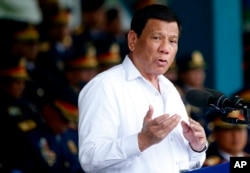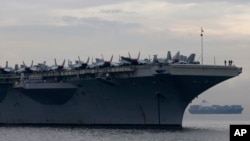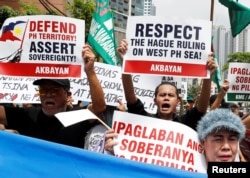The Philippines will increase the number of joint military exercises with the United States next year to rebuild ties with an old, widely trusted ally in case China threatens Manila’s sensitive maritime claims, despite a growing Beijing-Manila friendship.
Washington and Manila have agreed to hold 281 exercises in 2019, up from 261 this year, the Armed Forces of the Philippines website said in a statement Oct. 1. Both sides “look forward to ongoing, close cooperation” in counterterrorism, maritime security, humanitarian aid and disaster relief, the statement says.
Philippine President Rodrigo Duterte had scaled back aid from the world’s strongest military since taking office in 2016 and built ties with U.S. geopolitical rival China. But a lot of Filipinos, especially people in defense circles, indicate higher trust in the United States, a pre-World War II colonizer of the Southeast Asian archipelago.
Beijing for its part has built islets and moved military equipment into the South China Sea, where the Communist government disputes sovereignty with the Philippines and four other parties. An increase in joint exercises with the United States shows Duterte now acknowledges public fear about China, experts say.
“Lots of influential people in the Philippines continue to value the security partnership with Washington and fear Chinese domination, and in particular a Chinese creeping invasion of Philippine territory or the Philippine (marine) exclusive economic zone,” said Denny Roy, senior fellow at the East-West Center think tank in Honolulu.
Restoration of exercises
Large-scale annual U.S.-Philippine naval exercises in the South China Sea stopped in 2017. Duterte had thundered against U.S. assistance, saying “Bye-bye, America” in December 2016 after Washington questioned his deadly campaign against illegal drugs.
Now Duterte wants to restore the military relationship to show he’s balancing China ties with U.S. relations, said Jay Batongbacal, a University of the Philippines international maritime affairs professor. The 2019 exercises will effectively take Manila back to the level of joint military exercises before Duterte, he said.
“For him it’s good because it eases some pressure, especially from those within the security sector, armed forces included,” Batongbacal said. “It keeps at bay any criticism that he is aligning with China too much. Keeping the alliance active is like his way of hedging between the two major powers.”
Relations between Washington and Manila’s militaries are governed by a mutual defense treaty signed in 1951, obligating each side to back the other if attacked, as well as a 19-year-old Visiting Forces Agreement.
The Philippine armed forces gained public support last year after beating Islamic State-inspired Muslim rebels over five months of battles last year for control in a southern city, said Eduardo Araral, associate professor at the National University of Singapore’s public policy school. The United States donated arms to that fight.
“The fact that the Philippine has the U.S. alliance back means that the Filipino president can continue to diversity Manila’s external relations and foreign policy options without running excessive risks, and he can continue to keep the military happy by giving them what they want,” said Fabrizio Bozzato, a Taiwan Strategy Research Association fellow specialized in Asia and the Pacific.
Indonesia, Malaysia and Vietnam have crafted similar foreign policies, playing to China as well as the United States.
China matters
Duterte shows no signs of pulling back from China. Beijing and Manila aim now to sign a deal for joint undersea gas and oil exploration, although many Filipinos worry about an uptick in Chinese military activity in the disputed sea’s Spratly Islands.
Duterte traveled to China in October 2016 to meet counterpart Xi Jinping. China then pledged $24 billion in aid and investment. Some of that money will fund the Philippine president’s $169 billion infrastructure building program.
Next year’s U.S.-Philippine military exercises may be lower key than what the United States wants, Araral said. They will probably avoid “big amphibious military exercises that will antagonize China,” he said.
China may still complain about U.S. military aid, but it knows the Philippine-U.S. alliance is “very well rooted,” Batongbacal said.
Advantage for US
Washington hopes to keep relations strong with Philippines as part of a broader alliance with Asian democracies, including Japan and South Korea, scholars have said. The alliance effectively checks China’s maritime expansion.
The Philippines matters particularly now in case local opposition to U.S. bases grows in Okinawa or South Korea, Araral said.
“If you look at the big picture, the Philippines remains a very strategic and geopolitical asset to the United States and they don’t want to lose the Philippines to the Chinese,” Araral said. “So I suppose that this heightened military to military cooperation is part of that bigger picture of making sure that the U.S. will stay on and hang on while Duterte is there and hoping that the next president will be friendlier to the United States.”



